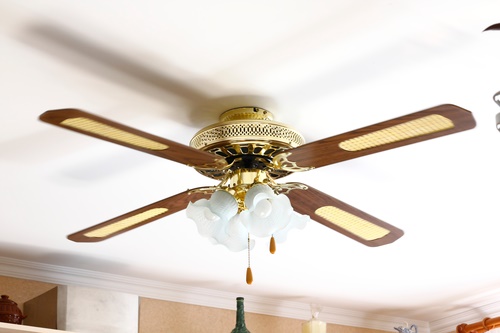Air circulation helps people fool cooler and more comfortable, because body heat gets pushed away from your immediate surroundings and because your air conditioning gets spread evenly throughout the room.
That’s why ceiling fans save energy — although it helps to know whether your current ceiling fan is energy-efficient. Let’s look at calculating the energy usage of fans and how you can save more energy.

Average Power Used by Ceiling Fans
Ceiling fans typically run between 10 and 80 watts, with many around 20-50. Larger models not advertised for energy efficiency often run at 75 watts or more.
To know for sure, you need to check the packaging or find a model number on the ceiling fan and search the manufacturer’s website for data.
Calculate a Ceiling Fan’s Energy Costs
If you know the wattage of your ceiling fan, you can use the handy appliance energy calculator from Energy.gov. They use the average California utility rate of $0.18/kWh.
For a really accurate estimate, consider some other factors:
Fan speed settings: Some fans use more power when operating at a higher speed, but that is not always the case. Older models tend to use the same power at any speed, while newer models use less energy at lower speeds.
Lights: Energy for a ceiling fan light is typically not included in the wattage of the fan. If you are looking to minimize energy consumption, remember to switch off the light if you aren’t using it.
Using a Ceiling Fan to Save Energy
Fans help you save money if — and really only if — you turn the thermostat up. A ceiling fan does have huge energy savings potential because they all cost less than air conditioning.
Even if you have a relatively inefficient 75-watt model and run it 24/7 year-round, it only comes out to $118.26 per year at $0.18/kWh. So for typical real-world situations, your ceiling fan is probably only costing you about a dollar per month. Compared to running the AC more, you can keep cool for far less!
Some tips for saving energy with a ceiling fan:
- Only use fans when people are in the room. Circulation does not decrease the actual air temperature, so it does not help your AC run more efficiently.
- Try lower or higher fan speeds. The tiny amount of extra energy used for a higher speed can easily be offset by increasing the thermostat one degree.
- In mild weather you can turn off the AC, run the ceiling fan, and crack windows for maximum circulation.
- Look at Energy Star certified ceiling fans. Energy Star rates fans based on airflow efficiency — not on the actual wattage! These units tend to have minimal wattage ratings, but more importantly, they provide the best cooling power when used in combination with a warmer thermostat setting.
Is Replacing a Ceiling Fan Worth It?
Newer ceiling fans can pay for themselves in energy savings while also making you more comfortable. Switch from a 75-watt fan to a 20-watt fan and your utility costs will be cut by more than two-thirds!
Quieter technology also makes it more pleasant to use your fan at high speeds. This further helps with energy costs because you’ll be more likely to run the fan and raise the thermostat. For more information on how you can benefit contact us at Spyrka Electric.

